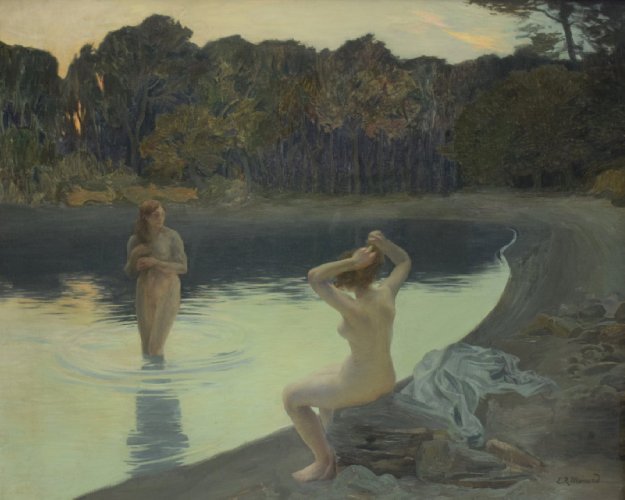Description:
Emile René Ménard (1862-1930) graduated from the Académie Julian in Paris. He exhibited at the Salon Société des Artistes Français. In his childhood he met Théodore Rousseau and Jean–François Millet, the Barbizon School painters. His father and uncle influenced his artistic development, inspiring his love of antiquity and philosophy. In search of ancient artifacts, he traveled to Greece, Sicily, Palestine and Italy. His work can be divided into two periods. Initially, he mainly painted mythological motifs and later, heroic landscapes with classical architecture and often with nude figures. He had a special affinity for the Breton landscape, which in his works became an Arcadian land of happiness, the desired end of his odyssey and a symbolic return home. He combined idealism with Impressionism, creating idyllic, intimate and symbolic landscapes with figures discovering them. He often alluded to mythical and Biblical meanings.
Description of the painting:
We therefore remain in the regions of Brittany. The characteristic line of sandy and stone coastline is brown-gray, matte. It contrasts with the shimmering water surface in the light of the setting sun. On the horizon, an almost uniform patch of lush crowns of trees covered with leaves was painted. They are reflected in the water as a dark, graphite-colored color spot. This time, the landscape is diversified by the scene of two female figures. In comparison with the work of Henri Jules Guinier “Landscape with a Woman’s Figure”, we went a little lower, to the bay itself. We look closely at the scene of the bath of two women. The motif presented by the painter was repeated many times. In the foreground, closest to the viewer, the artist depicted the silhouette of a naked woman who sat on a stone. Preparing for a bath, she carefully pins her chestnut hair, wanting to protect it from wetting. Part of the blue garment was abandoned here. The figure is turned to the viewer with its back. The second woman was immortalized during the bath. She stands still naked almost at the shore, with her legs to her knees immersed in water. With both hands, she twists her wet hair. Her body is just outlined and filled with beige-gray color spot. It was reflected without attention to anatomical details, as if they were not the most important here.
A woman looks towards the practically invisible forest painted on the right side of the painting’s field. Something has caught her attention, maybe even causing unease. She thus becomes an observer, herself being observed by the viewer-artist. Additional symbolic meaning is added to the work by the connection of the motif of the appearing nude woman emerging from the water with the mythical Aphrodite, the ancient symbol of beauty and love.


